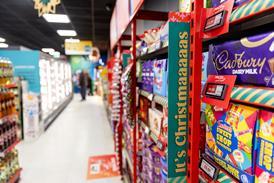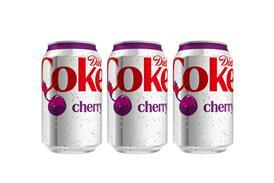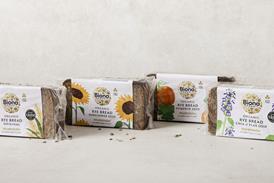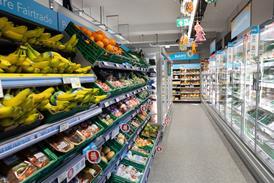While many laundry and cleaning products have become ‘concentrated’ and packs have been downsized, convenience retailers still struggle to make room for all the lines that are available. Then there are the new formats and fragrances to contend with. But the message from big players P&G, Reckitt Benckiser (RB) and Unilever is to stick to the well-known brands that are instantly recognisable.
Who buys what
Different consumers favour different detergent formats:
50.5% of households use powders - these are typically those with big families
42% of households use tablets - typically smaller households
28.6% use liquid dilutes - again smaller households
21% use capsules - empty nesters and households of two people with no kids
20.5% use liquid concentrates - bigger households of three-plus with kids
Source: Unilever Partners for Growth
Both P&G and Unilever - via their Shelf Help and Partners for Growth initiatives - offer planograms that retailers can follow.
P&G brand manager for homecare Will Herbertson says: “P&G would always suggest sticking to the basics and getting those in good shape before you start experimenting too much. For example, retailers should ensure they have a product to represent each of the cleaning needs - wipes, bathroom, kitchen and multi-purpose - before introducing additional lines that do the same job as an existing range.”
RB UK sales director Adam Rodgers agrees: “Every inch of shelf space has to work hard so it is important to have the right ‘basics’ in place so that the retailer can satisfy customer needs, but not have to carry too many different stock items. At RB we recommend a list of top products to ensure that customers can do all their spring cleaning - including the additional laundry (curtains and covers) and have their home clean, sparkling and smelling great.”
That top products list comprises: Cillit Bang grime & limescale Dettol surface cleaner trigger Finish all in one regular Harpic limescale Vanish pink stain remover and Air Wick aerosol.
Herbertson adds that as household products can sometimes be a last-minute purchase, they play directly into the hands of convenience retailers. “Those stores that ensure they have a well-stocked homecare aisle with key brands from leading manufacturers are in a great position to make the most of the growth opportunities available.
“Being able to find products easily is also important to these shoppers, so retailers should clearly lay out fixtures by room (kitchen or bathroom) then by task (dishes) then surfaces, ensuring that everything is well labelled on shelf.”
Space-a-plenty
Space or rather lack of it is something that’s not an issue for Jimmy Roberts who is manager of the 8,000sq ft EuroSpar Dolgellau in Gwynedd.
“We have seven 4ft bays with seven shelves in each bay and we also have a pricemarked/promotion bay within the fixture. Cleaning products, laundry and paper products are all displayed together along with the health and beauty and baby products section on the last aisle.
“We aim to carry as many products that are available to us as possible and we regularly check against planograms to make sure all available products are in the store.
“The paperware department is the best performer out of these, sales of the other categories could do better in my opinion but due to prices it’s very hard to compete with the multiples.”
The brighter days of spring that should be emerging soon show up cobwebs and smears on windows, which is why so many householders get into a frenzy of cleaning. Herbertson says now is the ideal time to trial new lines in store. “Limited-edition lines, new products and lines that have high visibility due to TV advertising are worth considering. In the past year, P&G has introduced an innovative gel-based cleaning format, Flash Liquid Gel, which has proven popular - so this would be one line it might be worth adding to meet the spring- cleaning rush.”
Alkesh Gadher, who has a Best-One in Isleworth, London, says that if there’s a new product out he feels they have to try it, but adds that manufacturers don’t push new cleaning products as much as new confectionery or soft drinks.
“I’ll try something new even if I have to make room for it on our front promotional bay,” he explains. “I’ll monitor sales for up to 12 weeks then delist it if it doesn’t sell.”
With cleaning products Alkesh says some people like those specifically for windows or for the kitchen, but a safer bet for retailers is a multipurpose product, “so you are catering for everyone”.
Anil Patel, who runs a Londis in Morden, London, also opts for multi-purpose products. “Washing-up liquid and bleach always sells, so I don’t mind stocking them and we’ll have two or three types. Typically, we’ll have Fairy and SuperValu washing-up liquid in yellow and green.”
Washing-up is an interesting topic. While in the grocery multiples dishwasher detergents sell better, in the convenience channel it’s different with just 39% of sales coming from auto dishwash products and 61% for traditional hand dishwash products (IRI data).
Partner up
Paul Mather, of Sherston Post Office Stores in Malmesbury, first discovered Unilever’s Partners for Growth (P4G) when he was at a Batleys sales development conference. From there he went onto the website and did a comparison between what he stocked in his laundry aisle and what P4G recommended.
“It was a case of looking at the actual content they recommended as well as the way it was displayed,” says Paul.
His first problem was the fact that he had some items that were not recommended. “I checked these lines against my epos data and found they weren’t selling so then had a mini ‘fire sale’ offering customers 25-33% to get rid of them and make more space on the fixture.
Despite following the P4G recommendations, Paul says you still need to bear in mind local demand in your store. “We sell loads of starch, for example. We have one lady who comes in and buys oceans of it for her ironing lady. So you need to know what works in your store and use P4G as a guide.”
And he adds that it would be wrong to assume that it will take you only an hour to do it. “You’ve got to be enthusiastic about it if you want it to work. And it worked for us, I was amazed as our epos showed our sales were up by more than 40%.”
Herbertson reckons this is generally down to the potential top-up nature of purchases at c-stores, with households more likely to run out of washing-up liquid than dishwasher products.
Retailers including Anil cite bleach as a must-stock product, and their instincts are right because, according to SIG data, it’s the fastest growing segment of the household cleaning category. It is growing at 6.5% and has contributed £7m-worth of category growth to the sector in the past year.
Although many consumers are happy to stick to an own label bleach, the brands have been selling well. One bottle of Domestos is sold every second in the UK, for example. And Jeyes Parozone is popular, with original thick bleach 750ml its best-selling line.
Both Alkesh and Anil say of household cleaning, laundry and paper products, it is the latter category that’s doing best for both of them.
Anil Patel has 3m for paper products and 3m for cleaning and laundry down the left-hand side of his Londis store, near the back.
“Paper products are more everyday items - toilet rolls and kitchen towels - so they sell better. We have a Lidl and Sainsbury’s nearby where our customers buy their bulkier packs they only come to us when they run out.”
His biggest sellers are own label (SuperValu) and Andrex, but he says they usually have a third line on promotion from Londis. “Customers tend to buy them more when they are on offer.
“It’s a similar story with kitchen rolls - we have two extremes. There are the people who buy the cheap or pricemarked packs and others who will only buy the quality ones - the ones that are as good as a cloth. Personally, I think it’s a false economy buying the cheaper ones, but I do like to give my customers a choice.”
It’s an opinion that Laura Burrows, brand manager for Plenty, would definitely agree with. “Our core range, which includes Plenty The Original One and Plenty The Fat One, offers excellent absorbency and durability even when wet, thanks to its advanced paper technology, so much so that 87% of Good Housekeeping readers would recommend Plenty The Original One to a friend.”
Merchandising
The house-building boom has been a boon for the toilet-care sector as more houses nowadays are built with downstairs loos and en suites.
According to Nielsen data, toilet care is currently worth £229m and growing 1%, with wipes and bleach driving this growth.
Bloo is the fastest-growing brand in the category, up 7% in MAT terms. Jeyes marketing director Yvonne Adam puts its success down to its diverse range, good distribution and recent new launches in cageless rims and liquid toilet cleaner.
But she says one key area which is often overlooked is ‘in-cistern’ where, on average, each in-cistern product delivers twice the value sales of a rim product.
Bloo has a 64% share of this market with citrus Twin In Cistern its best-seller.
She adds that Plenty The Big One has all the advantages of the core range, but with the added benefit of extra-large sheets. “Test results show these larger sheets are of real assistance to the consumer. The compact footprint also takes up less space.”
According to IRI data, the total paper market is worth £1.6bn with the household towel market worth £342m. Plenty is the UK’s number one household towel brand. It has seen consistent value growth since 2009, and currently holds a 24.4% share and is growing by 5.3%.
Retailers should look out for new packaging across the Plenty range, which will differentiate each product and highlight consumer usage.
In the laundry section, Daz is Anil’s best-seller at the moment, as well as Persil. He says he stocks quite a few variants and one of each particular format.
“We’ve tried so many types, we constantly have to review them to see if they are selling. If they’re slow sellers we discontinue them. To be honest, you could fill the shop with all these lines. You have to go on your instinct about what to stock and it can be a case of trial and error.”
Alkesh adds: “P&G’s new Surf is on promotion at £2.99. We sell a lot on promotion, but not off promotion, so you’ve got to ask yourself whether they’ve got the pricing right. Generally, Bold is number one for us, followed by Persil.”
Broad range
But there’s much more to the laundry category than just ‘main wash’ products. Tom Hazelden, Partners for Growth controller and retail execution manager for c-stores at Unilever, is concerned that some convenience stores are stocking only products for main wash, in particular powder products. This means they could be losing out on potential sales of other formats, such as liquids and capsules, as well as products designed for other elements of laundry, such as iron enhancers, stain removers and fabric softeners.
The sense of good scents
Wild orchid & velvet flowers, peony & roseblush, and white lily & crystal rain are just some of the exotic-sounding scents you’ll find in the household cleaning fixture.
Marloes Garben, brand manager for Persil at Unilever UK, says fragrance is a key driver in the laundry category where consumers are always looking for products “which have a stronger fragrance deliverance”.
Retailer Paul Mather of Sherston Post Office Stores in Malmesbury, agrees fragrance makes a difference: “Thanks to Unilever’s Partners for Growth merchandising advice we discovered a yellow variant of fabric conditioner to sell alongside the blue one. It became a best-seller. Customers had obviously seen it in the major supermarkets and were pleased to find it in our store, too.”
Scented laundry seems obvious, but fragrance is a key category driver in floor cleaning too. Indeed, the latest Cif floor cleaning product - Express Direct to Floor - comes in the aforementioned wild orchid & velvet flowers variant.
“Convenience retailers would benefit from broadening their range to suit a greater range of needs. Powders are still the largest sector of the market, accounting for 37% of value sales. However, shoppers have been quick to adopt the new formats. Liquids and gels combined now have a 37% value share of the total market. And concentrated liquids are becoming increasingly important. These formats satisfy a number of key customer requirements - environmental concerns, improved fragrance, reduced packaging - with a pack size which is highly suited to convenience.”
P&G’s Herbertson recommends that retailers site their homecare and laundry fixtures near to each other, as the two go hand in hand and this could help to encourage cross-purchase. “Make sure they have a good flow as well - we would recommend clearly laying out laundry shelves by wash stages and homecare fixture by room and product tasks. A further way to drive footfall would be to set up a spring cleaning display close to the front of the store.
“Retailers should use epos to assess the opportunity in laundry and homecare, in comparison to typically higher footfall drivers such as soft drinks and confectionery. That will ensure they have fully considered where there is room in-store to help drive extra sales.”
The final word on the vast category comes from Londis retailer Anil Patel, who would like to see manufacturers increase the margins on household and laundry lines as he says they’re on the low side. “I don’t know if there is a perception that we’re happy with margins of 18-20% on these items, but we’re not. We need a 30% mark up because the volume sales are not there. The supermarkets have killed the volume sales so we need better margins to survive.”
IN BRIEF
Persil campaign targets mums
P&G is targeting the mother and baby market for its latest Fairy Non Bio campaign. The activity aims to encourage mums to consider Fairy Non Bio as the first detergent for their babies.
Toilet cleaning with turbo power
New Domestos Turbo Fresh Rim Block rotates under the pressure of the water, evenly distributing the cleaning formula around the toilet bowl. The two parts work together to remove dirt and prevent limescale.
Mopping made easy with Cif
Cif Express Direct to Floor has been developed to offer consumers a mess-free, convenient cleaning product. The ‘squirt, mop and go’ product comes in three variants in a 750ml bottle. The launch is supported by a £1.7m marketing spend.
A price to please all consumers
McBride has launched Clean N Fresh all-purpose cleaner with the consumer-friendly rrp of just £1 per 1ltr bottle, along with a trigger pack of Oven Proud, rrp £1.
Thirst Pockets attracts attention
Thirst Pockets was recently relaunched with a new marketing strategy. Called The Magnetic Attraction, new activity shows how liquid is magnetically drawn into Thirst Pockets.
E-asy as pie
The e-cloth is proving popular with parents and those with allergies who are keen to explore chemical-free cleaning, as it uses just water. Convenience retailers should consider the general purpose cloth, rrp £4.99, and the glass & polishing cloth, rrp £4.99.
Moist manoeuvre
A new campaign from Kimberly-Clark aims to change the perception of moist toilet tissue and make it a part of consumers’ normal bathroom routine. The “Change What You Mean By Clean” activity will endeavour to increase awareness of Andrex Washlets as a product that gives consumers a superior clean.
Source
Tracy West
























